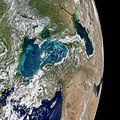Čeština: V letním období se na
Černém moři objevují barevné oblasti připomínající tahy malířským stětcem. Ve skutečnosti představují tyrkysově zbarvené plochy oblasti s vysokým výskytem
fytoplanktonu, které kopírují vodní prody a víry.
English: Most summers, jewel-toned hues appear in the Black Sea. The turquoise swirls are not the brushstrokes of a painting; they indicate the presence of phytoplankton, which trace the flow of water currents and eddies.
On May 29, 2017, the Moderate Resolution Imaging Spectroradiometer (MODIS) on NASA’s Aqua satellite captured the data for this image of an ongoing phytoplankton bloom in the Black Sea. The image is a mosaic, composed from multiple satellite passes over the region.
Phytoplankton are floating, microscopic organisms that make their own food from sunlight and dissolved nutrients. Here, ample water flow from rivers like the Danube and Dnieper carries nutrients to the Black Sea. In general, phytoplankton support fish, shellfish, and other marine organisms. But large, frequent blooms can lead to eutrophication—the loss of oxygen from the water—and end up suffocating marine life.
One type of phytoplankton commonly found in the Black Sea are coccolithophores—microscopic plankton that are plated with white calcium carbonate. When aggregated in large numbers, these reflective plates are easily visible from space as bright, milky water.
“The May ramp-up in reflectivity in the Black Sea, with peak brightness in June, seems consistent with results from other years,” said Norman Kuring, an ocean scientist at NASA’s Goddard Space Flight Center. Although Kuring does not study this region, the bloom this year is one of the brightest to catch his eye since 2012.
Other types of phytoplankton can look much different in satellite imagery. “It’s important to remember that not all phytoplankton blooms make the water brighter,” Kuring said. “Diatoms, which also bloom in the Black Sea, tend to darken water more than they brighten it.”
Español: Vista satelital del
mar Mediteraneo (abajo), el
mar Negro (centro) y el
mar Caspio (arriba). En el mar Negro a menudo aparacen tonos turquesas durante el verano. Estos indican la presencia de
fitoplancton, que rastrea el flujo de las corrientes de agua.
Magyar: Műholdfelvétel a
hu:Fekete-tengerwFekete-tengerről és környékéről. A tengerben látható türkiz kanyarulatok
fitoplanktonok jelenlétére utalnak
Italiano: Il
Mar Nero d'estate, i vortici turchesi indicano la presenza di
fitoplancton.
Македонски: Тиркизни вртлози од летен
фитопланктон во
Црното Море.
Nederlands: 's Zomers kleurt het water van de
Zwarte Zee vaak
turquoise door de aanwezigheid van
fytoplankton
Polski: Fotografia satelitarna
Morza Czarnego (w środku),
Morza Śródziemnego (u dołu) oraz
Morza Kaspijskiego (u góry, z prawej strony). W okresie letnim na Morzu Czarnym zazwyczaj pojawiają się turkusowe kłęby. Jest to
fitoplankton unoszony przez morskie
prądy i wiry.
Português: Vista por satélite do
mar Mediterrâneo (abaixo), do
mar Negro (centro) e do
mar Cáspio (acima). No mar Negro, tons de turquesa aparecem frequentemente durante o verão. Estes indicam a presença de
fitoplâncton, que rastreia o fluxo das correntes de água.
Русский: Спутниковая фотография
Чёрного моря. Видны также Каспийское, Средиземное и Азовское моря. Бирюзовые фигуры на фото указывают на наличие
фитопланктона в Чёрном море.
Українська: Компіляція
супутникових знімків циркуляції поверхневих вод у
Чорному морі. Бірюзовий колір вказує на активний розвиток
фітопланктону.
اردو: بحیرہ اسود میں اکثر موسم گرما میں جواہرات نما رنگ آ جاتے ہیں۔ فیروزی رنگ کے بھنور کسی برش کی پینٹنگ نہیں ہے؛ یہ
نبات تیراکہ کی موجودگی کو ظاہر کرتے ہیں، جو پانی کی دھاراؤں اور گردابوں کے بہاؤ کا پتہ لگاتے ہیں۔






